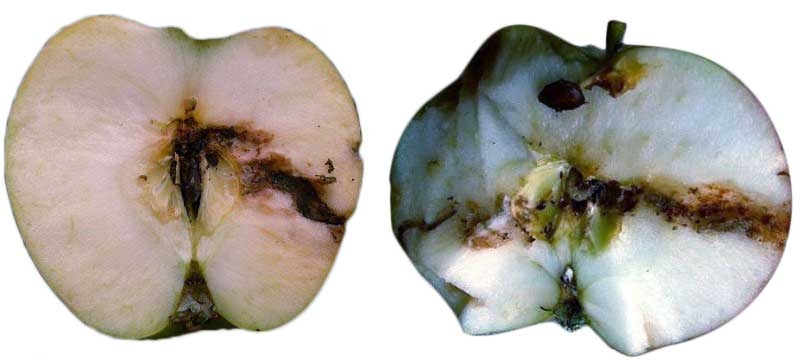Timing is the key to the successful application of insecticides for Codling moth control
One of the most dangerous pests of apples that an orchardist is faced with is codling moth.
Besides apples, it also attacks pears, quinces and occasionally walnuts and stone fruit.
It is a hard pest to control because once the grub is inside the apple it is safe from insecticides and predators.
Management programs
Management programs for Codling moth are based on preventing larval entry into the fruit.
These programs are timed by heat-driven models that are synchronized to field populations by first capture of overwintering moths in pheromone traps.
Proper timing of insecticide sprays is critical. Insecticides should be applied before or just as eggs are hatching.
Once the worm has entered the fruit or nut it is protected from pesticides.
If insecticides are applied too late, larvae will have tunnelled into the fruit where they can no longer be controlled by insecticides.
Pheromone traps & biofix
Pheromone traps are used to establish the biofix (biological fix point) for the model.
The life stage and relative size of a codling moth population can be determined using the degree day model (see Table 1) and pheromone traps.
Pheromone traps should be checked twice per week to determine biofix, or the initial emergence of over-wintering first generation moths.
Biofix occurs when there is an average of more than three moths caught in a trap over a 3 to 5 day period.
For the rest of the season, these traps can be an effective way to monitor not only population cycles, but also the relative success of insecticide sprays.
Stage of moth development
Trap counts can be used in combination with degree-days (DD) to accurately pinpoint the stage of moth development.
The degree day model (see Table 1) is based on a developmental threshold of 10C for moth development and works as follows:
Begin calculating degree-days at biofix.
Calculate the maximum and minimum temperatures for each day and fit them into the following equation: [(Max + Min)/2]-10.
The daily DD counts should be summed and accumulated as the season progresses.
IPM program
Codling moth can be very difficult to manage, especially if the population has been allowed to build up over a season or two.
It is much easier to keep moth numbers low from the start than to suppress a well-established population.
An IPM program for codling moth management consists of different tools such as insecticides, mating disruption, and cultural controls.
Mating disruption
Mating disruption is the preferred tool because of its low toxicity to people, natural enemies, and the environment—but it may need to be supplemented with insecticide sprays, especially during the first few years.
Cultural methods
Cultural methods for Codling Moth management include pruning and thinning, removal of alternate hosts and removal of dropped fruit.
Pruning and thinning allows greater insecticide spray penetration and coverage.
Pear and walnut trees should either be removed from sites near the orchard, or included in any codling moth treatments applied to the rest of the orchard.
Apples that will not be picked from young nursery trees should be removed early in the season.
Raking and removing apples on the ground will prevent larvae maturing in dropped apples.
Cardboard wrapping around the trunk and main branches can be used as non-chemical method for reducing of population of Codling moth. This provides a perfectly shaped place for the grub to spin its cocoon. This band needs to be taken off and destroyed.
Soft chemicals
Combinations of soft chemicals and pheromone-based mating disruption have proven effective in control of Codling moth. Use of lower toxicity and selective insecticides enhances populations of beneficials.
Mating disruption
Mating disruption is a technique, where the female sex pheromone of the codling moth is released in enormous quantities in the orchard, preventing the male moth from locating the female for mating.
This technique is safe for non-target insects and doesn’t leave pesticide residues on the fruit.
In orchards under a regular spray program, pheromone traps loaded with a 1-mg lure and placed in the lower to mid-level of the canopy are sufficient for monitoring purposes. However, in mating disruption blocks, the pheromone traps should be loaded with a 5 to 10 mg lure, and the traps should be placed in the upper canopy of the tree.
(Continued next moth)
See this article in Tree Fruit September 2016
(Published with permission from the Fruit Growers Victoria website. Article and photos are the property of Fruit Growers Victoria.)




















